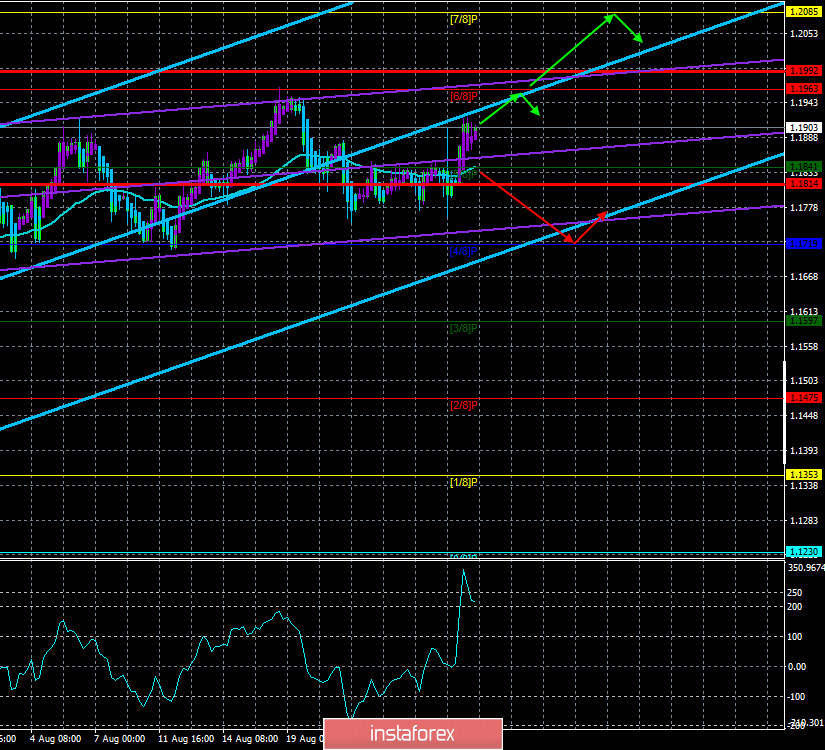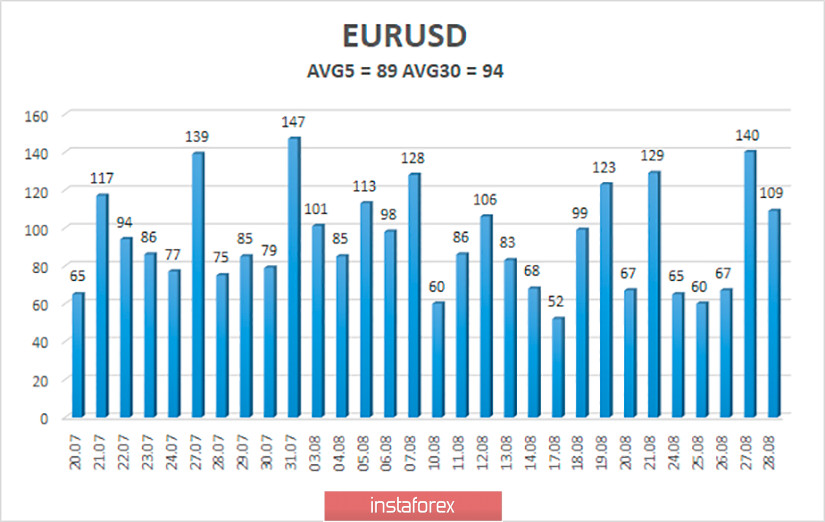4-hour timeframe

Technical details:
Higher linear regression channel: direction - upward.
Lower linear regression channel: direction - upward.
Moving average (20; smoothed) - sideways.
CCI: 215.6401
For the EUR/USD pair, the last trading day of the week turned into a new round of upward movement within the side channel, which is limited to the levels of $1.17 and $1.19. If you switch to the "language" of the "linear regression channels" system, then the Murray levels are "4/8"and "6/8". Thus, nothing has changed in technical terms over the past week. The upward trend continues. Buyers remain wary of making major new purchases of the euro currency near its two-year highs. Let's be honest and frank, there has been no downward correction; there are no new fundamental factors that could support the euro or put pressure on the US dollar. Thus, the bulls' doubts are absolutely logical. As for the bears of the EUR/USD pair, they simply do not believe in the dollar, and also do not have a particularly good reason to buy it, since no optimistic information is received from overseas. Moreover, there is no information coming from the European Union at all. In America, all the "four crises" remain, and a fifth, constitutional one is on the way – if Trump loses the election and refuses to leave office or starts a series of lawsuits accusing the Democrats of falsifying the election results. We have already written about all the crises repeatedly, as well as about the fact that America has turned against Donald Trump and does not want his re-election. Thus, the US dollar may even continue to weaken in the coming months. Only technical factors speak in its favor.
Thus, all the questions on the foreign exchange market now come down to what can stop the fall of the US currency? And when it might happen. If you try to look only at the fundamental and macroeconomic factors, the choice is not so great. The trade war with China is unlikely to end soon and the "coronavirus" continues to rage in the States. Several vaccines are being tested, however, independent doctors continue to say that it is not a problem to create a vaccine, the problem is to put it through all the necessary tests and prove that it is safe for all segments of the population, for people of all ages. Such tests can take months, if not years. The US President hopes that by the end of the year, the States will have their own vaccine. And in addition, the American President continues to make pretentious statements. "Defeating the coronavirus will happen faster than people think, with or without vaccines. This is already happening," Trump said at a speech in North Carolina.
Creating a vaccine in the US could really stop the US dollar from falling. However, we believe that this would only be a temporary respite for the US currency. The problem is that in the euro/dollar pair, the economies of the European Union and America are most important. Thus, we believe that to complete the fall of the dollar, America needs to stop the spread of the "coronavirus". With lockdown, with the vaccine, with mask mode and distance, it doesn't matter. As long as people are infected, this will create risks for the US economy, which already collapsed by 33% in the second quarter. But the situation in the European Union is much better, so the general fundamental background really supports the euro currency. First, many EU countries managed to stop the spread of COVID-2019. Yes, with the arrival of autumn in France and Spain, the number of diseases began to increase again, however, in many EU countries, the daily number of infections does not exceed 1,000, which is very small. Thus, it is safe to say that the situation with the epidemic in Europe is much more favorable. Second, the EU economy shrank by just 12.1% in the second quarter, almost three times less than the loss of the US economy. Third, the European Union has agreed on a budget for 2021-2027 and a 750 billion euro economic recovery fund. The United States continues to pour several trillion dollars into the economy every few months and brought its public debt to 30 trillion in 2020. Meanwhile, the economy requires new injections, as unemployment remains high, and the "coronavirus" could not be stopped. Accordingly, economic and business activity remains low, which hinders the recovery. Thus, if we consider only the fundamental factors, the dollar should really become cheaper. Another question is that all these factors have already been played out by the markets several times. The dollar can't always get cheaper for the same reasons! Moreover, we have already said that for the whole of 2019, the US dollar rose against the euro by 2 cents. Over the past three months, the euro has risen against the dollar by 12 cents and there has not even been a correction.
Thus, so far, the prospects for the US currency remain very vague. We can see that despite the sideways movement in the last month, market participants found no reason to buy the dollar during this time. This means that the upward movement can continue. There will be no macroeconomic reports on the first trading day of the new week. On Tuesday, the consumer price index in the European Union and the ISM and Markit business activity indices for the manufacturing sector in the United States will be released. We continue to draw traders' attention to the fact that the pair rarely reacts to macroeconomic statistics in recent months. However, a strong discrepancy between the forecasts and the actual values of important reports can cause a short-term market reaction, which is very important for intraday traders or in the short term. Therefore, you should not skip publications and reports anyway.

The volatility of the euro/dollar currency pair as of August 31 is 89 points and is characterized as "average". Thus, we expect the pair to move today between the levels of 1.1814 and 1.1992. Although the boundaries of the side channel are more important at this time, in which the pair has been moving for more than a month. A downward reversal of the Heiken Ashi indicator will signal a new round of downward movement within this very channel.
Nearest support levels:
S1 – 1.1841
S2 – 1.1719
S3 – 1.1597
Nearest resistance levels:
R1 – 1.1963
R2 – 1.2085
R3 – 1.2207
Trading recommendations:
The EUR/USD pair is moving towards the upper line of the side channel. Thus, today we can continue to trade higher with the goals of 1.1963 and 1.1992, however, we strongly doubt that traders will be able to overcome the levels of 1.1900 and 1.1963. If the price is fixed below the moving average, it is recommended to trade lower with the goal of the Murray level of "4/8"-1.1719, but even in this case, the positions opened should be small and cautious.
 English
English 
 Русский
Русский Bahasa Indonesia
Bahasa Indonesia Bahasa Malay
Bahasa Malay ไทย
ไทย Español
Español Deutsch
Deutsch Български
Български Français
Français Tiếng Việt
Tiếng Việt 中文
中文 বাংলা
বাংলা हिन्दी
हिन्दी Čeština
Čeština Українська
Українська Română
Română

